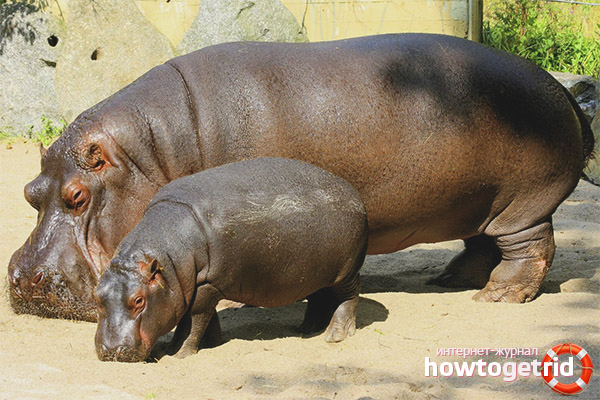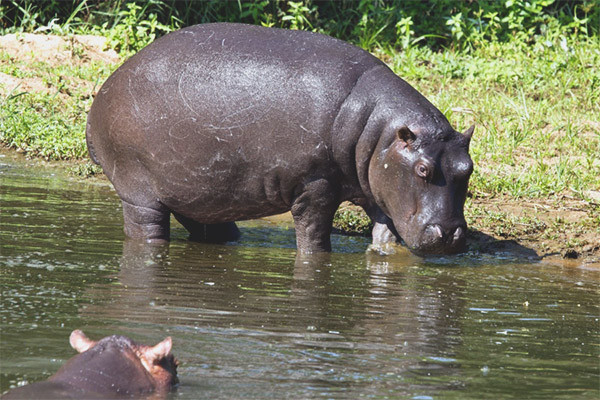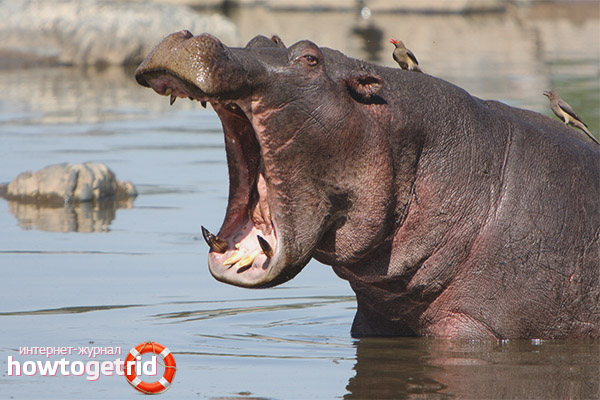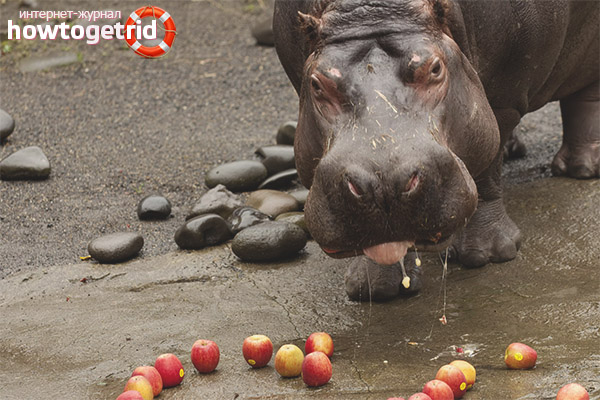The content of the article
Hippos are also called hippos, belong to the hoofed mammals. Their family is called hippo. They are considered one of the largest animals on earth and lead a rather interesting lifestyle.
Description
Hippos are the second heaviest animals on earth. The first place is occupied by elephants, and the third place is occupied by rhinos.
Scientists have long wanted to determine the origin of hippopotamuses, their lineage from ancient times. For a long time, researchers thought that the hippo had the strongest kinship with pigs. Their similar appearance spoke about it. But recent studies have shown that hippos are related to whales by origin. This explains their semi-aquatic lifestyle.
The body of hippos is protected by a thick layer of skin. They can take colors from purple-gray to gray-green.Skin color changes in the areas around the eyes, as well as around the ears of the animal. Here the skin may be brownish pink.
The weight of an adult hippo can reach 4000 kilograms. On average, these animals weigh from 1.3 to 3.2 tons. The hippopotamus has a tail, its length can reach thirty-five centimeters. The body itself has a length of from two to five meters. The height of an adult animal varies from 1.5 to 1.6 meters.
During fights in the wild wildlife, hippos can be injured because their outer skin is not very strong. Hippopotamuses have almost no wool, hairs covering the body are thin, almost invisible. A more abundant coat can only be seen on the head and tail of the animal.
It is interesting that hippos have neither sweat nor sebaceous glands. Instead of the natural secretions we are used to, their glands produce a viscous red liquid. At first, the researchers thought that this liquid was a mixture of sweat and blood. But long surveys have shown that these are actually two acids, mixed together. In combination with each other, they protect the animal's skin from overheating, and also have an antiseptic and antibacterial effect. Under the influence of sunlight, the liquid on the skin of a hippopotamus changes color.If at first it is transparent, then it becomes brick-colored.
It is a mistake to consider hippos to be sedentary, slow and clumsy. In order to protect their lives and the lives of the family, these animals can move in their habitat rather quickly.
On land, they can move at a speed of 30 km / h. And to maintain such speed for quite some time. In the water, hippos can become even faster, this is explained by the structure of their limbs, which are adapted for movement in shallow waters.
Another interesting fact is that the structure of the head of a hippopotamus, namely, its ears, nostrils and eyes, allows these animals to stay out of the surface for a long time, being under a layer of water, escaping from danger. In this case, the animal can fully control what is happening around him. If the hippopotamus completely wants to go under the water, then he closes his ears and eyes, protecting them from water.
If we talk about the teeth and jaws of a hippopotamus, they can seem rather formidable animals. Their fangs can reach a length of fifty centimeters, and the incisors can be forty centimeters in size. At the same time, hippos are able to open their mouth at an angle of more than 150 degrees, which looks very frightening.But it must be said that such a jaw structure meets the needs of chewing large amounts of grass, and not hunt other animals.
It should be noted that gender is clearly traced in hippopotami. Males are much larger than females. Female hippos weigh only 200 kilograms, while male hippos can weigh several tons. Females grow for a limited amount of time, and males can grow longer throughout their life. The jaws of the males also look the most intimidating, compared with females.
The largest hippo, which the researchers recorded, weighed more than 4.5 tons.
Habitats
Hippos love to live in shallow water, it can be shallow swamps, rivers or lakes. These animals need the body to be fully submerged under water, therefore the depth of the reservoirs should be about two meters.
In the daytime, hippos do not lead an active lifestyle. In the midst of the day, animals are overcome by sleep; they can sleep in shallow ponds or even in mud. In this case, hippos never rest alone, they sleep in groups, their bodies touch. Here, mating acts and childbirth can occur.
If the hippos during the day for any reason can not be in shallow ponds, they pass through to dive into the deep waters. At this time, above the water surface of these animals are only nostrils. This situation allows them to breathe, as well as to be unnoticed by others.
When it is evening in nature, and the bright sun is almost gone below the horizon, the hippopotamuses wake up and begin to carry on their food-producing activities, and also simply to move and change their location. Hippos always choose paths they know for themselves, only danger can change their place to sleep. From familiar reservoirs they do not go further than two kilometers, if there are no extraordinary circumstances. At the same time, they prefer to move in their usual environment along the banks of reservoirs.
Scientists can not provide data on the size of the territory, which is occupied by hippos. The area of the territory depends on how many hippos are in the herd. At the same time, as mentioned earlier, hippos never rest alone, preferring close companies and contact with each other.
Today, hippos are most often found only on the African continent. Previously, they met in other places, but were killed because of poaching activities.Hunting for these animals was carried out for meat.
Hippo lifestyle
Hippos never live alone. This is due to their perennial habits from the moment they appear. One herd of hippos can number from 20 to 100 animals. Group dwelling is explained by safety, few predators are capable of attacking a group of such large animals. As already mentioned, the main activity in the life of a hippopotamus comes with the arrival of the evening. Only then hippos begin to look for food for themselves and offspring.
The role of males in the herd of hippos is to ensure the protection and safety of female individuals and young. Females provide a quiet and measured sleep in the daytime on the shore or shallow water, they control their young, allowing everyone to enjoy the rest.
It is important to note that male hippos are distinguished by aggressive behavior. When a male reaches the age of seven, he becomes a full member of the group. This event gives rise to his struggle for territory and position in the herd. For this there are various methods in the animal world.This includes the roar, and the wide opening of the mouth, and the sprinkling of other individuals with manure and urine.
Thus, they want to show their strength and power, but it can be very difficult for young male individuals to strengthen their position in the herd. Here their rivals are adult hippos who are ready to engage in battle with their relatives for a place in the sun. The extreme measure may be the murder of a young opponent.
Males very carefully monitor the territory belonging to them. They seize possession with the help of marks. Males refer to their territory and a place for recreation, and a place for food. Even if the male hippopotamus do not see other applicants, they still tag their possessions. For conquering and capturing new places, hippos can even get out of the water outside office hours.
Hippos communicate with each other using sounds. About the dangers of hippos always warn each other. They can spread sound waves in the water. The roar of them can be compared with the roar of thunder during a thunderstorm. In the entire animal world, only hippos can communicate with each other under a layer of water. Their roar is heard for congeners, both on land and in the water.Hippos are capable of transmitting sound messages to each other even when only its nostrils rise above the water.
At the moment when the body of a hippopotamus is immersed in water, the head of this animal can serve as an island for birds, from where they can catch fish and get food for themselves. Hippos react to birds calmly. This is due to the existence of a certain tandem between them. This alliance is justified by the fact that the birds help the behemoth to get rid of the parasites that live on its whole body. Even around the eyes of a hippopotamus can live unpleasant worms that can deliver a lot of inconvenience. Birds also feed on these parasites, making it easier for hippos to live.
Such an alliance with birds can be considered an exception, since hippopotamuses are not at all calm and peace-loving animals. They are dangerous in their habitat. With the help of powerful jaws, hippos can even kill a crocodile in an instant.
The behavior of hippos is often unpredictable, especially this unpredictability is peculiar to males and females that protect their young. If another animal has angered a hippopotamus, then he is able to kill him.This can occur under different circumstances. A hippo can gnaw at the victim's throat, trample it, tear it apart with the help of fangs, or simply drag it away to the depths.
Nutrition
For all its seeming danger, hippos are herbivores. Pastures hippos choose near their usual water bodies. For them, there are no natural enemies in the wild, but they do not want to change familiar places. They like pastures where there is a lot of grass. If grass is not enough, hippos can go on long journeys in search of new places where food will be enough for everyone.
The process of feeding adults is quite long and can take up one fifth of a day. This is due to the fact that the behemoth at a time is able to eat up to forty kilograms of vegetation. Hippos are not picky at all in the choice of grasses, they like the shoots of trees, the reeds, and other vegetation that can be found near the usual waters.
An amazing feature in the diet of hippos is that they can eat and the remains of dead animals that are found near water bodies, although this happens quite rarely and is a deviation in their behavior.Scientists attribute this fact to the lack of any nutrients, as well as the state of health of the hippopotamus. This behavior is also considered strange because hippo's digestion is not suitable for digesting meat.
Another difference hippos from other herbivores is that they do not chew grass, but simply tear it with their teeth or sip it with the help of powerful lips that are created for this mission.
After the meal, hippos tend to return to their usual reservoir before sunrise, but if the hippopotamus’s journey to the succulent grass was a long one, then it can also go into unfamiliar water for rest. Under the scorching sun, hippos move extremely rarely.
Reproduction and longevity

Hippos are not monogamous animals, because in the herd there will always be several lonely partners. During the search for partner males are quiet, they do not need conflicts with others.
When a hippopotamus finds a suitable female, he lures her into the water, where the fertilization process itself takes place. All this should occur at a sufficient depth.In this case, the female hippopotamus is constantly submerged under water, the male jealously watches this. Scientists say that this is due to the fact that the female in this position is more agreeable.
At the time of returning to the group of hippos, the children are already protected by males. During the year, the female feeds the calf with milk, then it eats another food. An adult cub can be considered only when it reaches the age of three and a half years.
In general, hippos live in the wild for about forty years. In special conditions, hippos can live to be sixty years old.Meanwhile, how many hippopotamuses live and the state of their teeth have a certain relationship, if the teeth of an adult individual began to wear out, this means that his life has gone to a close and probably will end soon.
Video: Hippopotamus (Hippopotamus amphibius)














To send